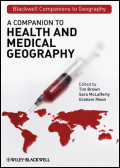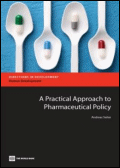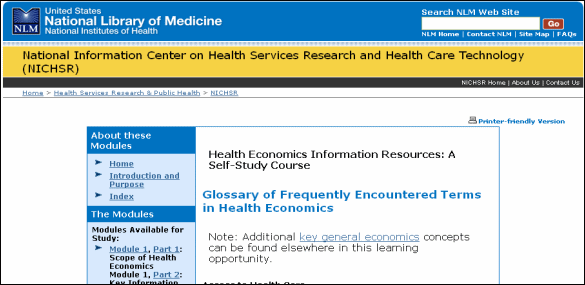SELECTED FOR YOU... NOVEMBER-DECEMBER 2010: books of the month - sites of the month - working papers
All the Selected for you
BOOKS OF THE MONTH
A companion to Health and Medical Geography.
Un compagnon à la géographie de la santé et à la géographie médicale.
Brown T. / éd., McLafferty S. / éd., Moon G. / éd.
Malden : Blackwell Publishing : 2010 : XXII-610 p
This Companion provides a comprehensive account of health and medical geography and approaches the major themes and key topics from a variety of angles. It offers a unique breadth of topics relating to both health and medical geography. It Includes contributions from a range of scholars from rising stars to established, internationally renowned authors and provides an up-to-date review of the state of the sub-discipline. Thematically organized sections offer detailed accounts of specific issues and combine general overviews of the current literature with case study material. Other chapters cover topics at the cutting edge of the sub-discipline, including emerging and re-emerging diseases, the politics of disease, mental and emotional health, landscapes of despair, and the geography of care (4e de couverture).
A practical approach to pharmaceutical policy.
Approche pratique de la politique du médicament.
Seiter A.
Washington : The World Bank : 2010 : 215 p.
Pharmaceuticals are an essential component of health care. But for many people in low- and middle-income countries, access to the medicines they need to prevent or treat severe illnesses is limited. Typical problems are lack of availability, costs that exceed the individual's purchasing power or lack of competent “agents” – health workers that are well trained to give the correct advice on which medicines to take. Pharmaceutical policy is the part of health policy that aims at addressing these problems and increasing access to safe, effective and affordable medicines for all patients. There are many obstacles against achieving these goals. Such obstacles can arise from financial interests on the side of suppliers and health care providers, who may benefit from charging higher prices and issuing more prescriptions than might be justified from a clinical and economic viewpoint. Or from rogue suppliers trying to introduce low quality or counterfeit drugs into markets with less effective regulation. Also, corruption and ineffective bureaucracies sometimes interfere with well intended programs to offer access to essential medicines for the poor.This book offers policy makers a hands-on approach, tested in the World Bank's field work in many countries, for assessing the pharmaceutical sector, recognizing typical “patterns of dysfunction” and developing strategies to quickly deal with the most urgent problems while at the same time building a platform for sustainable long term policy. It offers examples from a variety of low- and middle income countries and provides practical assessment tools for policy makers. The book ends with the author's outlook on future developments in this complex policy field (4e de couverture.)
SITES OF THE MONTH
Glossary of Frequently Encountered Terms in Health Economics
www.nlm.nih.gov/nichsr/edu/healthecon/glossary.html
WORKING PAPERS
Health inequalities
Analysing the socioeconomic determinants of health in Europe: new evidence from EU-SILC. 

Analyse des déterminants socioéconomiques de l'état de santé en Europe : nouvelles évidences provenant de EU-SILC.
Commission Européenne. Luxembourg.
Luxembourg : Publications Office of the European Union : 2010/11 : 45 p.
Le présent document présente une analyse des inégalités en termes de limitations dans les activités quotidiennes liées à l'état de santé, en s'appuyant sur les données longitudinales de l'EU-SILC pour les vagues 2005 à 2007 dans 20 États membres de l'UE pour lesquels des données sont disponibles. Ces inégalités ont été mesurées en utilisant une approche basée sur les indices de concentration. Nous avons complété l'analyse par une analyse par décomposition des indices de concentration afin de différencier les principales causes des inégalités liées au revenu en matière de santé. Nous avons mis en évidence des inégalités liées au revenu dans tous les pays étudiés, bien qu'ils affichent une évolution hétérogène. L'analyse de régression montre que les facteurs démographiques comme l'âge et le sexe influent sur la déclaration de limitations dues à l'état de santé. En outre, des facteurs tels que la situation au regard de l'emploi, l'éducation et différents indicateurs d'exclusion sociale jouent un rôle très important dans la perception des limitations liées à la santé dans les activités quotidiennes, comme le montrent les résultats de l'analyse de régression et de l'analyse par décomposition. Les limites de cette étude sont plus amplement abordées dans un document de travail méthodologique (Hernández-Quevedo et al, 2010).
Methodological issues in the analysis of the socioeconomic determinants of health using EU-SILC data. 

Problèmes méthodologiques pour l'analyse des déterminants socioéconomiques de l'état de santé mesurés via les données EU-SILC.
Commission Européenne. Luxembourg.
Luxembourg : Publications Office of the European Union : 2010/11 : 35 p
Les inégalités liées à la santé entre les divers groupes socio-économiques constituent des préoccupations de santé et d'ordre public dans tous les pays. Grâce aux disciplines que sont l'épidémiologie et l'économie, nous disposons d'outils méthodologiques très fiables pour mesurer les inégalités de santé à travers les différents pays. L'étude de ces inégalités génère toutefois de nombreux problèmes méthodologiques. Dans cet article, nous étudions le biais de déclaration potentiel et les méthodes alternatives incluses dans d'autres enquêtes de santé afin d'y remédier. Nous opérons ensuite une distinction entre l'indice de concentration à court terme et à long terme, en nous fondant sur les données longitudinales figurant dans l'EU-SILC. Nous examinons également l'indice de concentration corrigé proposé par Erreygers (2009) pour pallier les insuffisances du «vieil» indice de concentration. Enfin, nous concluons par une analyse des besoins non satisfaits en termes d'examen ou de traitement médical et dentaire et de leurs principales causes, à l'aide des données disponibles dans l'EU-SILC.
Drugs
PHIS (Pharmaceutical health information system) Hospital Pharma Report. 

Rapport sur le médicament à l'hôpital du projet PHIS.
European Commission. Executive Agency for Health and Consumers. (EAHC). Bruxelles. BEL,
Austrian Federal Ministry of Healh. (BMG). Vienne. AUT
Vienne : OBIG : 2010 : 188 p.
Le projet PHIS (Pharmaceutical health information system) a pour objectif de collecter et mettre à disposition des informations sur les politiques de médicament dans les pays européens (http://phis.goeg.at.). Le rapport annuel de synthèse inclut les premiers résultats d'une enquête sur les prix de 12 produits dans 25 hôpitaux et 5 pays (Autriche, Norvège, Pays-Bas, Portugal, ,République slovaque). Bien que l'enquête ne soit pas représentative, les résultats sont intéressants (la Norvège paye plusieurs produits moins cher que le Portugal, les producteurs se font concurrence pour vendre à prix nul, etc...).
Choosing Among Competing Blockbusters: Does the Identity of the Third-Party Payer Matter for Prescribing Doctors? 

Choisir entre des blockbusters concurrents : L'identité du tiers payeur influence-t-elle la prescription des médecins ?
Dalen D.M., Sorisio E., Strom S.
Munich : Center for Economic Studies : 2010 : 25 p.
TNF-alpha inhibitors represent one of the most important areas of biopharmaceuticals by sales, with three blockbusters accounting for 8% of total pharmaceutical sale in Norway. With use of a unique natural policy experiment in Norway, this paper examines to what extent the identity of the third-party payer affects doctors' choice between the three available drugs. We are able to investigate to what extent the price responsiveness of prescription choices is affected when the identity of the third-party payer changes. The three dominating drugs in this market, Enbrel, Remicade, and Humira, are substitutes, but have had different and varying funding schemes - hospitals and the national insurance plan. We find that treatment choices are price responsive, and that the price response is considerably higher when the doctor's affiliated hospital covers the cost instead of a traditional fee-for-service insurance plan. When the doctors' hospitals are covering the cost of this treatment instead of insurance the total cost of treatment is significantly reduced.
Primary health care
Physicians self selection of a payment mechanism: Capitation versus fee-for-service 

L'auto-sélection par les médecins de leur mode de rémunération : la capitation versus le paiement à l'acte.
Allard M., Jelovac I., Leger P.T.
Ecully : Groupe d'Analyse et de Théorie Economique : 2010/10 : 20 p.
The main question raised in this paper is whether GPs should self select their payment mechanism or not. To answer it, we model GPs' behavior under the most common payment schemes (capitation and fee-for-service) and when GPs can select one among those. Our analysis considers GPs heterogeneity in terms of both ability and sense of professional duty. We conclude that when savings on specialists costs are the main concern of a regulator, GPs should be paid on a fee-for-service basis. Instead, when failures to identify severe conditions are the main concern, then payment self selection by GPs can be optimal.
Why Junior Doctors Don't Want to Become General Practitioners: A Discrete Choice Experiment from the MABEL Longitudinal Study of Doctors. 

Pourquoi les jeunes médecins ne veulent-ils pas devenir médecins généralistes : une expérimentation à choix discret issue de l'enquête longitudinale MABEL sur les médecins.
Sivey P., Scott A., Witt J.
Melbourne : Melbourne Institute of Applied economics and social research : 2010 : 33 p.
A number of studies suggest there is an over-supply of specialists and an under-supply of GPs in many developed countries. Previous econometric studies of specialty choice from the US suggest that a number of factors play a role, including expected future earnings, educational debt, and having predictable working hours. Given endogeneity issues in revealed preference studies, a stated-preference approach is warranted. This paper presents results from a discrete-choice experiment completed by a sample of 532 junior doctors in 2008 before they choose a specialty training program. This was conducted as part of the first wave of the MABEL (Medicine in Australia: Balancing Employment and Life) longitudinal survey of doctors. We include key job attributes such as future earnings and hours worked, but also allow the choice to be influenced by academic research opportunities, continuity of care and the amount of procedural work. Interactions of attributes with doctor characteristics, including gender, educational debt, and personality traits are also examined. We find the income/working hours trade-offs estimated from our discrete choice model are close to the actual wages of senior specialists, but much higher than those of senior GPs. In a policy simulation we find that increasing GPs' earnings by $50,000, increasing opportunities for procedural or academic work can increase the number of junior doctors choosing General Practice by between 8 and 16 percentage points, approximately 212 to 376 junior doctors per year. The results can inform policymakers looking to address unbalanced supply of doctors across specialties.
Health care system
Health Systems in Transition (HIT) : The Netherlands. 

Systèmes de santé en transition : Pays-Bas
Schofer W., Kroneman M., Boerma W. et al.
Copenhague : OMS, Bureau régional de l'Europe : 2010 : 229 p.
Ce document fournit une description analytique et mise à jour du système de santé en transition (HiT) des Pays-Bas, ainsi qu'une synthèse des programmes de réforme en développement. L'organisation structurelle du système de santé, les processus de décision, le financement et les dépenses de santé, l'organisation du système de soins et l'allocation des ressources sont abordés. Ce rapport a été réalisé par l'Observatoire européen des Systèmes et des Politiques de santé dans le cadre du projet HiT (Health Care Systems in Transition).
Regional variation in the productivity of the English National Health Service. 

Variation régionale de la productivité du Service national de santé anglais.
Bojke C., Castelli A., Laudicella M., Street A., Ward P.
York : University of York : 2010/03 : 34 p.
At a time when there are severe pressures on reducing public spending there is increasing emphasis on determining which parts of the country secure best value for money in the NHS. By linking together large scale and routinely collected datasets we produce and compare productivity estimates across the ten Strategic Health Authorities in England in 2007/08.
Long-term care
Are You Well Prepared for Long-term Care? – Assessing Financial Gaps in Private German Care Provision. 

Etes-vous bien préparés aux soins de longue durée ? Evaluation des écarts financiers dans l'offre de soins privés en Allemagne.
Keese M., Meng A., Schnabel R.
Bochum : Ruhr-Universität Bochum : 2010 : 29 p.
The development of expenditure for care services is one of the most intensively debated topics in public. However, studies calculating financial provision gaps only focus on the macro-level implications for the compulsory care insurance. In contrast, this paper examines the individuals' micro-level perspective. We use survey as well as regional and national statistical data to calculate expected individual costs of long-term care on a very detailed care arrangement and care level basis. Afterwards, we compare these costs with the individuals' total wealth. In our most conservative policy scenario, our results show that about a third of statutorily insured individuals will have to face a financial care provision gap. Among homeowners, an even higher share will have to liquidate the main residence. The privately insured are affected to a somewhat lower extent. In both groups, the situation will become much more severe if the development of public transfers does not keep up with future increases of long-term care costs. Furthermore, regression analyses show that provision gaps are more frequent among statutorily insured individuals, females, and individuals in single households.
Work and Health
What determines transitions to sick leave? 

Qu'est-ce qui détermine les congés maladie ?
Andreassen S., Kornstadt T.
Turin : Université de Turin : 2010 : 13 p.
The paper discusses some of the possible determinants of sick leave. The underlying medical health of workers is of course important, but other factors also determine if they manage to function at work. For example the degree to which workers are willing to endure discomfort at work and the demands for efficiency at work can be important. Also of importance is the ease with which workers can change jobs and whether increases in employment bring in marginal, less healthy, workers. Finally, one must take into consideration the ability of firms to accommodate workers with health problems, the age of the work force and the situation workers face at home. As an illustration, we discuss how these factors have influenced married women in ages 35 to 44 using a multinomial model. The main finding is that changes in wages has had a very strong effect on transitions to sick leave in the 90's. In our estimation they explain almost all the change in the group.
Ageing
Attrition and Health in Ageing Studies: Evidence from ELSA and HRS. 

Attrition et santé dans les études sur le vieillissement : évidence issue des enquêtes ELSA et HRS.
Banks J., Alastair M., Smith J.P.
Santa Monica : Rand corporation : 2010 : 40 p.
In this paper the authors present results of an investigation into observable characteristics associated with attrition in ELSA and the HRS, with a particular focus on whether attrition is systematically related to health outcomes and socioeconomic status (SES). Investigating the links between health and SES is one of the primary goals of the ELSA and HRS, so attrition correlated with these outcomes is a critical concern. They explored some possible reasons for these differences. Survey maturity, mobility, respondent burden, interviewer quality, and differing sampling methods all fail to account for the gap. Differential respondent incentives may play some role, but the impact of respondent incentive is difficult to test. Apparently, cultural differences between the US and Europe population in agreeing to participate and remain in scientific surveys are a more likely explanation.
Financial circumstances, health and well-being of the older population in England : The 2008 English Longitudinal Study on Ageing (Wave 4). 

Attrition et santé dans les études sur le vieillissement : évidence issue des enquêtes ELSA et HRS.
Banks J. / éd., Lessof C. / éd., Nazroo J. / éd. et al.
Londres : Institute of Fiscal Studies : 2010 : 428 p.
The English Longitudinal Study of Ageing (ELSA) was set up with both research and policy as central objectives. With ageing of the population now a global phenomenon, it is of utmost importance to understand the health, well-being and the economic and social circumstances of older people. The longitudinal nature of ELSA provides researchers with increasing opportunities to determine how to put people on trajectories of economically secure older life, with good health, well-being and social engagement. The answers to these research questions will be fundamental to the development of policy. Participants in ELSA are interviewed every two years. After each wave we produce a report which provides insight into the data collected. The previous report, produced after wave 3, was based on data collected in 2006-07 and examined several themes, including contributing to society through paid work, material well-being, health and quality of life. It highlighted the contribution of respondents' expectations, physical health and pension provision as well as, where relevant, partners' employment status, to ongoing employment in this cohort of over-50-year-olds. It showed that wealth was increasing in the over-50s, largely due to increasing housing wealth (growing house prices) with only small increases in non-housing wealth (financial and physical wealth but not pension wealth). Findings in that report also showed that being single, having a low level of pension provision and being out of the labour force were related to income poverty but that reaching state pension age was not, of itself, a driver of poverty of income. Income poverty is one of the possible consequences of low-level pension provision and being out of the labour force. Lower quality of life is another, since lower quality of life was found among those who were poorer as well as those who lived alone or had poor physical health.


